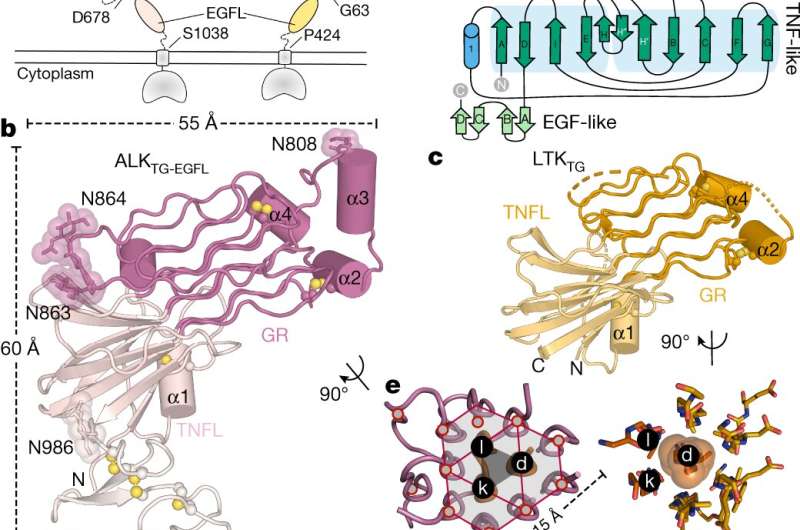3D structure of cell receptor with critical role in health and disease

Cells communicate with their environment via receptors on their surface. When a protein approaches these receptors, they can pass along a message to the inside of the cell, for example the instruction to grow which can lead to tumor formation. New research by the team of prof. Savvas Savvides (VIB-UGent, Belgium), the National Cancer Research Institute (Tokyo, Japan), the Memorial Sloan Kettering Cancer Center (New York, U.S.), and ℏ bioconsulting (Minnesota, U.S.) reveals the 3D structure of the ALK receptor, which is involved in various cancers and other diseases. These insights can lead to the understanding of the function of these receptors, the first important step towards therapeutic approaches. The work appears in the journal Nature.
Message from the outside
Cells communicate with their environment via proteins that attach to receptors on the cell surface. Think of these receptors as communication antennas that can only receive specifically encoded signals. When an appropriate signal from outside the cell—in the form of a specific protein for the receptor—approaches the antenna, the signal will be communicated to the inside of the cell. This can initiate many important cellular processes, such as cell growth and division.
When the communication between such proteins and receptors becomes uncontrolled, excessive, or interrupted, this can lead to severe diseases such as cancer, inflammatory, or autoimmune disorders. A group of receptors central to human health is known as the receptor tyrosine kinases (RTKs). We have about 58 of these RTKs organized into 20 families. Functional defects in these receptors are relevant for several cancers, autoimmune, neurological diseases, and metabolic disorders.
Meeting ALK
Due to their critical roles in physiology and disease, most RTKs have been well-researched, but for one group, the ALK family, information is sorely lacking. We've known about them for over three decades, and yet structural information about how they interact with their signaling proteins remained a question mark.
This new study, spearheaded by Ph.D. student Steven De Munck from the team of prof. Savvas Savvides (VIB-UGent Center for Inflammation Research) has now revealed the 3D structure of ALK and LTK, another RTK, as well as their structures when bound to their activating proteins. This is critical information for understanding the function of these receptors.
Steven De Munck: "We were surprised by how unique and unprecedented these proteins and their assemblies are, illustrating how basic research is essential for uncovering novel concepts and mechanisms in disease-causing processes."
ALK and its mutated versions are involved in, for example, the pediatric cancer neuroblastoma, colon cancer, melanoma, and possibly also obesity. However, the lack of structural insight has prevented the specific therapeutic targeting of ALK receptors.
Prof. Savvides emphasizes the impact of their finding: "Frontline research in structural biology is vital for addressing difficult problems in biology, no matter how challenging such research might appear to be. It takes a team of talented and dedicated scientists like Steven to achieve breakthroughs like this, which will inspire innovative therapeutic approaches and open new biomedical questions."
More information: Steven De Munck et al, Structural basis of cytokine-mediated activation of ALK family receptors, Nature (2021). DOI: 10.1038/s41586-021-03959-5
Journal information: Nature
Provided by Ghent University




















